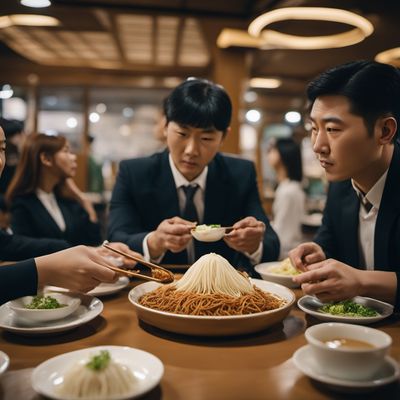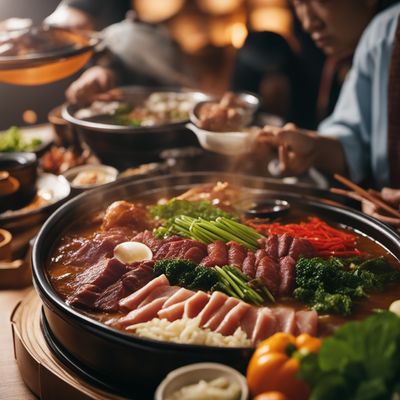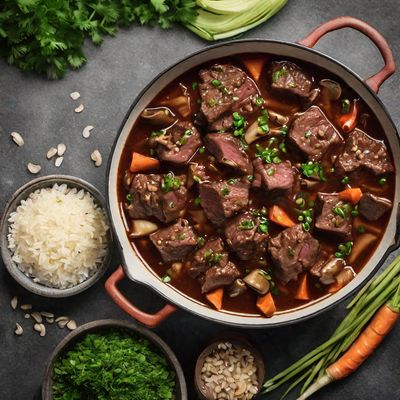
Recipe
Kimchijeon - Korean Kimchi Pancake
Savory Delight: Crispy Kimchi Pancake with a Korean Twist
4.7 out of 5
Indulge in the flavors of Korean cuisine with this authentic Kimchijeon recipe. This savory pancake, made with fermented kimchi and a crispy exterior, is a popular dish in Korean households and street food stalls.
Metadata
Preparation time
15 minutes
Cooking time
15 minutes
Total time
30 minutes
Yields
4 servings
Preparation difficulty
Easy
Suitable for
Vegetarian, Vegan (if eggs are omitted), Dairy-free, Nut-free, Low calorie
Allergens
Wheat (gluten), Soy
Not suitable for
Gluten-free (due to the use of all-purpose flour), Paleo, Keto, High protein, Low carb
Ingredients
-
1 cup (120g) all-purpose flour 1 cup (120g) all-purpose flour
-
1 cup (240ml) water 1 cup (240ml) water
-
2 large eggs 2 large eggs
-
1 cup (200g) kimchi, finely chopped 1 cup (200g) kimchi, finely chopped
-
1/4 cup (30g) scallions, thinly sliced 1/4 cup (30g) scallions, thinly sliced
-
2 cloves garlic, minced 2 cloves garlic, minced
-
1 tablespoon soy sauce 1 tablespoon soy sauce
-
1 tablespoon sesame oil 1 tablespoon sesame oil
-
Vegetable oil, for frying Vegetable oil, for frying
Nutrition
- Calories (kcal / KJ): 220 kcal / 920 KJ
- Fat (total, saturated): 8g, 1g
- Carbohydrates (total, sugars): 30g, 3g
- Protein: 7g
- Fiber: 2g
- Salt: 1.5g
Preparation
-
1.In a large mixing bowl, combine the all-purpose flour, water, and eggs. Whisk until a smooth batter forms.
-
2.Add the chopped kimchi, sliced scallions, minced garlic, soy sauce, and sesame oil to the batter. Mix well to ensure all ingredients are evenly incorporated.
-
3.Heat a non-stick skillet or frying pan over medium heat. Add enough vegetable oil to coat the bottom of the pan.
-
4.Pour a ladleful of the batter onto the pan, spreading it evenly to form a round pancake.
-
5.Cook the pancake for 3-4 minutes on each side, or until golden brown and crispy.
-
6.Repeat the process with the remaining batter, adding more oil to the pan as needed.
-
7.Once cooked, transfer the pancakes to a paper towel-lined plate to remove any excess oil.
-
8.Cut the pancakes into wedges and serve hot with a dipping sauce made of soy sauce, vinegar, and sesame oil.
Treat your ingredients with care...
- Kimchi — Use well-fermented kimchi for the best flavor. If your kimchi is too sour, you can rinse it lightly before chopping.
- Scallions — Ensure the scallions are thinly sliced to distribute their flavor evenly throughout the pancake.
- Garlic — Freshly minced garlic provides a robust taste, but you can also use garlic powder as a substitute.
- Soy sauce — Opt for low-sodium soy sauce if you prefer to control the saltiness of the dish.
- Vegetable oil — Use a neutral-flavored oil with a high smoke point, such as canola or grapeseed oil, for frying.
Tips & Tricks
- For extra crispiness, you can add a tablespoon of cornstarch to the batter.
- Customize the level of spiciness by using mild or spicy kimchi according to your preference.
- Serve the Kimchijeon with a side of Korean pickled vegetables or a refreshing cucumber salad.
- Experiment with different dipping sauces, such as a spicy gochujang-based sauce or a tangy soy-vinegar dip.
- Leftover Kimchijeon can be reheated in a toaster oven or skillet for a quick and delicious snack.
Serving advice
Serve the Kimchijeon hot, either as a main course or as a side dish. Cut it into wedges and present it on a platter, garnished with additional sliced scallions for a pop of color.
Presentation advice
To enhance the presentation, sprinkle some toasted sesame seeds and a drizzle of sesame oil over the Kimchijeon. Serve it alongside a small bowl of the dipping sauce for an inviting and appetizing display.
More recipes...
For Korean cuisine » Browse all
More Korean cuisine dishes » Browse all

Garaetteok
Rice cake
Garaetteok is a traditional Korean dish made from cylindrical-shaped rice cakes. It is a popular street food and is often served in soups or...

Pyongyang naengmyeon
Pyongyang Naengmyeon
Pyongyang naengmyeon is a Korean cold noodle dish that is perfect for hot summer days. The dish is made with thin, chewy noodles made from...

Gopchang jeongol
Gopchang Hot Pot
Gopchang jeongol is a Korean dish that is made with beef tripe and vegetables. The dish is spicy, flavorful, and perfect for sharing with friends...






